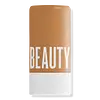What's inside
What's inside
 Key Ingredients
Key Ingredients

 Benefits
Benefits

 Concerns
Concerns

 Ingredients Side-by-side
Ingredients Side-by-side

Hc Orange No. 5
Zinc Oxide 14%
Cosmetic ColorantWater
Skin ConditioningCaprylic/Capric Triglyceride
MaskingCoco-Caprylate
EmollientTrimethylsiloxysilicate
EmollientIsopropyl Palmitate
EmollientDimethicone/Vinyl Dimethicone Crosspolymer
Skin ConditioningPolyglyceryl-4 Diisostearate/Polyhydroxystearate/Sebacate
EmulsifyingOctyldodecyl Oleate
EmollientEthylhexyl Palmitate
EmollientIsopropyl Myristate
EmollientDimethicone
EmollientMagnesium Sulfate
Beeswax
Emulsion StabilisingGluconolactone
Skin ConditioningPropanediol
SolventIsoeicosane
EmollientGlycerin
HumectantSodium Hyaluronate
HumectantLecithin
EmollientRibes Nigrum Seed Oil
EmollientRosmarinus Officinalis Leaf Extract
AntimicrobialSolidago Virgaurea Extract
Skin ConditioningPolyhydroxystearic Acid
EmulsifyingPolyglyceryl-3 Polyricinoleate
EmulsifyingIsostearic Acid
CleansingSodium Benzoate
MaskingHydrogenated Castor Oil
EmollientTetrahexyldecyl Ascorbate
AntioxidantOctyldodecanol
EmollientOctyldodecyl Stearoyl Stearate
EmollientAlcohol
AntimicrobialPaeonia Suffruticosa Root Extract
Skin ProtectingPrunus Amygdalus Dulcis Oil
Skin ConditioningCitrus Aurantium Bergamia Fruit Oil
MaskingCitrus Aurantium Dulcis Peel Oil
MaskingRosa Damascena Flower Oil
MaskingSalvia Sclarea Oil
MaskingCitrus Aurantium Dulcis Flower Oil
AstringentVanilla Planifolia Fruit
MaskingCalcium Gluconate
HumectantSodium Chloride
MaskingMica
Cosmetic ColorantTocopherol
AntioxidantPhenoxyethanol
PreservativeCI 77891
Cosmetic ColorantIron Oxides
Limonene
PerfumingGeraniol
PerfumingHc Orange No. 5, Zinc Oxide 14%, Water, Caprylic/Capric Triglyceride, Coco-Caprylate, Trimethylsiloxysilicate, Isopropyl Palmitate, Dimethicone/Vinyl Dimethicone Crosspolymer, Polyglyceryl-4 Diisostearate/Polyhydroxystearate/Sebacate, Octyldodecyl Oleate, Ethylhexyl Palmitate, Isopropyl Myristate, Dimethicone, Magnesium Sulfate, Beeswax, Gluconolactone, Propanediol, Isoeicosane, Glycerin, Sodium Hyaluronate, Lecithin, Ribes Nigrum Seed Oil, Rosmarinus Officinalis Leaf Extract, Solidago Virgaurea Extract, Polyhydroxystearic Acid, Polyglyceryl-3 Polyricinoleate, Isostearic Acid, Sodium Benzoate, Hydrogenated Castor Oil, Tetrahexyldecyl Ascorbate, Octyldodecanol, Octyldodecyl Stearoyl Stearate, Alcohol, Paeonia Suffruticosa Root Extract, Prunus Amygdalus Dulcis Oil, Citrus Aurantium Bergamia Fruit Oil, Citrus Aurantium Dulcis Peel Oil, Rosa Damascena Flower Oil, Salvia Sclarea Oil, Citrus Aurantium Dulcis Flower Oil, Vanilla Planifolia Fruit, Calcium Gluconate, Sodium Chloride, Mica, Tocopherol, Phenoxyethanol, CI 77891, Iron Oxides, Limonene, Geraniol
Octyldodecanol
EmollientDipentaerythrityl Hexahydroxystearate/Hexastearate/Hexarosinate
Skin ConditioningPolyethylene
AbrasiveBeeswax
Emulsion StabilisingTheobroma Cacao Seed Butter
EmollientPersea Gratissima Oil
Skin ConditioningLecithin
EmollientMicrocrystalline Wax
Emulsion StabilisingSilica
AbrasiveMica
Cosmetic ColorantJojoba Esters
EmollientVp/Hexadecene Copolymer
Phenoxyethanol
PreservativeCaprylyl Glycol
EmollientTocopheryl Acetate
AntioxidantTriethoxycaprylylsilane
Iron Oxides
CI 77891
Cosmetic ColorantCI 19140
Cosmetic ColorantOctyldodecanol, Dipentaerythrityl Hexahydroxystearate/Hexastearate/Hexarosinate, Polyethylene, Beeswax, Theobroma Cacao Seed Butter, Persea Gratissima Oil, Lecithin, Microcrystalline Wax, Silica, Mica, Jojoba Esters, Vp/Hexadecene Copolymer, Phenoxyethanol, Caprylyl Glycol, Tocopheryl Acetate, Triethoxycaprylylsilane, Iron Oxides, CI 77891, CI 19140
 Reviews
Reviews

Ingredients Explained
These ingredients are found in both products.
Ingredients higher up in an ingredient list are typically present in a larger amount.
Beeswax is natural wax produced by honey bees and can be synthetically created. It consists mainly of fatty acid esters and long-chain alcohols.
In cosmetics, beeswax is a emollient. Due to its waxy structure, it creates a protective barrier. This barrier prevents water from evaporating off the skin.
This may not be a good ingredient for oily skin. We recommend speaking with a professional if you have concerns.
Beeswax cannot be removed with water, but can be taken off with an oil cleanser.
Beeswax is also antiseptic and contains vitamin A.
Learn more about BeeswaxCi 77891 is a white pigment from Titanium dioxide. It is naturally found in minerals such as rutile and ilmenite.
It's main function is to add a white color to cosmetics. It can also be mixed with other colors to create different shades.
Ci 77891 is commonly found in sunscreens due to its ability to block UV rays.
Learn more about CI 77891Lecithin is a term for a group of substances found in the cell membranes of plants, animals, and humans. They are made up of mixture of phospholipids.
This ingredient has emollient and emulsifying properties.
As an emollient, lecithen helps soften the skin and creates a barrier to keep moisture in.
As an emulsifier, it also helps prevent water and oil ingredients from separating. Lecithin can also help ingredients be better absorbed by the skin.
This is because the phospholipids in lecithin produce liposomes. Liposomes help other ingredients get through the skin barrier.
Depending on the source of this ingredient, lecithin may not be fungal acne safe. This is because some sources of lecithin come from soybean oil, which may feed the malassezia yeast that feeds fungal acne.
We recommend reaching out to the brand you are purchasing from to inquire about the source of their lecithin.
Some other names for this ingredient include soy lecithin and deoiled soy lecithin.
Learn more about LecithinMica is a naturally occurring mineral used to add shimmer and color in cosmetics. It can also help improve the texture of a product or give it an opaque, white/silver color.
Serecite is the name for very fine but ragged grains of mica.
This ingredient is often coated with metal oxides like titanium dioxide. Trace amounts of heavy metals may be found in mica, but these metals are not harmful in our personal products.
Mica has been used since prehistoric times throughout the world. Ancient Egyptian, Indian, Greek, Roman, Aztec, and Chinese civilizations have used mica.
Learn more about MicaOctyldodecanol is a fatty alcohol. It is primarily used to enhance the texture of products.
As an emulsifier, Octyldodecanol helps prevent the oils and waters from separating. It also prevents ingredients from creating foam when shaken.
Octyldodecanol is created by reducing fatty acid to an alcohol.
Due to its high molecular weight, it does not get absorbed into the skin.
Learn more about OctyldodecanolPhenoxyethanol is a preservative that has germicide, antimicrobial, and aromatic properties. Studies show that phenoxyethanol can prevent microbial growth. By itself, it has a scent that is similar to that of a rose.
It's often used in formulations along with Caprylyl Glycol to preserve the shelf life of products.
This ingredient is a combination of red, black, and yellow iron oxide pigments. This combination of colors is usually found in foundation, because it results in a "skin" color.